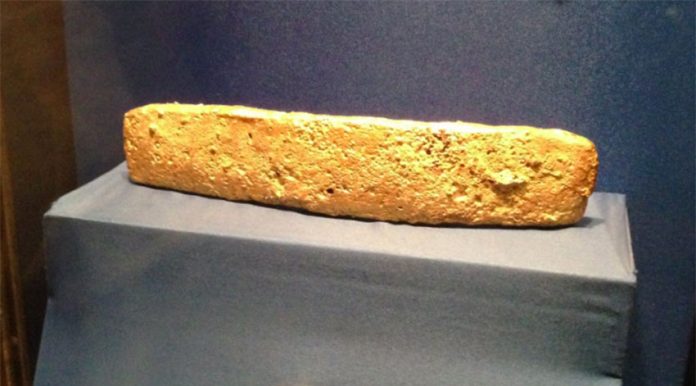A scientific analysis of a gold ingot found beneath a Mexico City street almost 40 years ago has confirmed that it was part of the Spanish plunder with which conquistadores led by Hernán Cortés attempted to escape the Aztec capital of Tenochtitlán in 1520.
The National Institute of Anthropology and History (INAH) said in a statement that a fluorescent X-ray chemical analysis had determined that the ingot was cast between 1519 and 1520. The timeframe corresponds to a period in which Cortés ordered gold stolen from the Aztecs to be melted into bars so that they could be transported more easily to Spain.
That information, coupled with the fact that the gold bar was found along a route used by the conquistadores to flee Tenochtitlán after a battle on June 30, 1520 that cost the lives of many Spaniards, led archaeologists to conclude that it was part of the Spanish booty.
The announcement from INAH comes six months before the 500th anniversary of La Noche Triste (The Night of Sorrows) as the Aztec revolt that drove the Spaniards out of the city came to be known.
The day before the battle in which many of the Spaniards’ indigenous allies also lost their lives, the Aztec, or Mexica, emperor Moctezuma II was killed, triggering the uprising.
The ingot – which weights 1.93 kilograms and is 1.4 cm thick, 26.2 cm long and 5.4 cm wide – was found 4.8 meters underground on March 13, 1981 during a government construction project on Hidalgo Avenue, located adjacent to the Alameda Central park in downtown Mexico City.
The bar is believed to have fallen or been thrown into a canal as the Spanish fled on horseback along a causeway leading out of Tenochtitlán, which was built on an island in Lake Texcoco.
INAH archaeologist Leonardo López Luján said the ingot is a “key piece” in the “puzzle” of the events of June 30, 1520. He noted that its length is exactly the same as ingots described by conquistador and chronicler Bernal Díaz del Castillo.
López also said that the Florentine Codex, an encyclopedic work about the people and culture of pre-Hispanic central Mexico, says that the Mexicas searched the canals after the battle of La Noche Triste to look for plundered objects. One illustration shows a man with a gold bar in his left hand, he added.
The gold ingot, which is on display at the National Museum of Anthropology in Mexico City, is a “material witness” of the Spanish conquest and a “unique archaeological” relic of the Night of Sorrows, the archaeologist said.
Mexico News Daily
